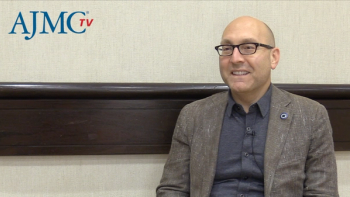
Peter Lio, MD, a dermatologist and clinical assistant professor at Northwestern Feinberg School of Medicine, discusses strategies for managing pediatric atopic dermatitis and how proper management can impact the disease course.

Peter Lio, MD, a dermatologist and clinical assistant professor at Northwestern Feinberg School of Medicine, discusses strategies for managing pediatric atopic dermatitis and how proper management can impact the disease course.

Pirtobrutinib led to improved outcomes compared with venetoclax in patients with relapsed chronic lymphocytic leukemia (CLL) following covalent Bruton tyrosine kinase inhibitor therapy.

Anna Sureda, MD, PhD, of the Catalan Institute of Oncology, discusses the evolving treatment landscape for patients with relapsed/refractory diffuse large B-cell lymphoma (DLBCL) or follicular lymphoma.

In this final segment of our interview with Ontada's Jessica K. Paulus, ScD, she explains how her team's data presented at the American Society of Clinical Oncology annual conference may translate to the real world.

Learn more about the 2025 Physician Fee Schedule, new health equity initiatives, improving maternal health, and pharmaceutical innovations at the Center on Health Equity & Access.

Jennifer Miller, MD, a pediatric endocrinologist at Lurie Children's Hospital, discusses the challenges of systemic corticosteroid use in children, such as adrenal suppression and growth delays.

Results from a national survey of patients with Duchenne muscular dystrophy (DMD) and their families found that patients and families want to be informed early about endocrine complications associated with glucocorticoid treatment.

No increased risks of preterm birth or perinatal outcomes were identified with maternal vaccination status, according to one study.

The Society for Pediatric Dermatology (SPD) Annual Meeting featured a new debates segment where experts in the field discussed preferred strategies for the treatment of pediatric skin conditions.

Doug Fulling, MA, discussed how introducing payers into clinical research earlier could help manufacturers, payers, and patients.

A Danish study found that living in cities with fewer than 50,000 residents and in newer, owned, and less dense homes is associated with a lower risk of developing chronic obstructive pulmonary disease (COPD).

Community support and molecular epidemiological approaches could help HIV prevention in Australia.

Twice-daily application of 1.5% ruxolitinib cream was found to be effective in children and adolescents with atopic dermatitis and vitiligo.

A multicenter pilot study concluded that dual therapy in spinal muscular atrophy (SMA) does not provide further benefits to infants at risk for SMA type 1.

Breast-conserving therapy for BRCA1/2 mutation carriers has higher risks of future breast cancers than the general population, but most patients avoid another cancer event, and many remain bilateral mastectomy–free after 20 years.

Pfizer announced plans for a once-a-day weight-loss pill; toxic metals have been found in over a dozen popular tampon brands across the US; CMS proposed a new rules impacting telehealth in the Medicare physician fee schedule (PFS) for 2025.

Patients with both diabetes and atherosclerotic cardiovascular disease (ASCVD) have about 1.5 times higher total direct health care expenditures than those without diabetes.

The 2025 Physician Fee Schedule includes a conversion factor reduction, expanded behavioral health services, extended telehealth waivers, new Quality Payment Program pathways, and measures to address suspect billing, alongside a Biden administration initiative introducing federal maternal health standards for hospitals.

The US Senate Committee on Health, Education, and Labor Pensions discussed actionable solutions to address the medical debt crisis impacting millions of individuals.

Today, the Siftwell 2024 Medicaid-Eligible Health Equity Index report highlighted ongoing challenges and barriers that underscore the need for systemic changes to improve health care access and outcomes for vulnerable groups.

Jessilin Quint, OD, MBA, FAAO, from Smart Eye Care, and Rebecca Petris, co-founder of the Dry Eye Foundation, spoke about their biggest takeaways from a recent dry eye survey conducted by The Harris Poll on behalf of Bausch + Lomb.

The Federal Trade Commission (FTC) is preparing a lawsuit against the 3 largest drug middlemen over their use of rebates for insulin and other drugs; Sen Bernie Sanders (I, Vermont) feels confident that Novo Nordisk will cut Ozempic and Wegovy costs after hearing; CMS proposed a payment rule that would increase Medicare reimbursement for hospital outpatient departments by 2.6% next year.

Cigarette smoking among other modifiable risk factors were significantly associated with cancer cases and deaths.

A nomogram model that included log odd of positive lymph node was effective in predicting prognosis of early-onset colorectal cancer (EOCRC).

On this episode of Managed Care Cast, we're talking with the chief medical officer of CVS Health about recent pharmaceutical innovations, patient-provider relationships, and strategies to reduce drug costs.

A new study has found that myasthenia gravis does not affect the long-term prognosis of patients with thymoma.

The annual number of publications on macrophages and pulmonary fibrosis jumped during 2017 and 2020, with signs pointing to more focus on research in these fields.

A post-hoc analysis showed that zanubrutinib resulted in fewer adverse events compared with ibrutinib.

Patient outcomes in this trial were compared between the regimens of lenalidomide, bortezomib, and dexamethasone and daratumumab, lenalidomide, bortezomib, and dexamethasone for use against multiple myeloma (MM).

A case study describes the disparate factors that played into the chemotherapy and other treatment decisions made by a team in Japan when addressing their patient’s primary mediastinal large B-cell lymphoma (PMBCL).

259 Prospect Plains Rd, Bldg H
Cranbury, NJ 08512
© 2025 MJH Life Sciences®
All rights reserved.
